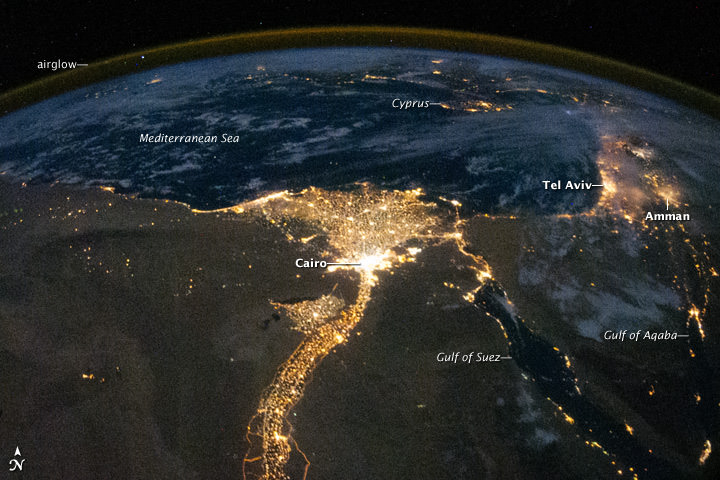[/caption]
When it comes to searching for ET, current efforts have been almost exclusively placed in picking up a radio signal – just a small portion of the electromagnetic spectrum. Consider for a moment just how much lighting we here on Earth produce and how our “night side” might appear as viewed from a telescope on another planet. If we can assume that alternate civilizations would evolve enjoying their natural lighting, wouldn’t it be plausible to also assume they might develop artificial lighting sources as well?
Is it possible for us to peer into space and spot artificially illuminated objects “out there?” According to a new study done by Abraham Loeb (Harvard), Edwin L. Turner (Princeton), the answer is yes.
For gathering light, the array of Earthly telescopes now at science’s disposal are able to confidently observe a light source comparable in overall brightness to a large city — up to a certain distance. Right now astronomers are able to measure the orbital parameters of Kuiper belt objects (KBOs) with the greatest of precision by their observed flux and computing their changing orbital distances.
However, is it possible to see light if it were to occur on the dark side? Loeb and Turner say that current optical telescopes and surveys would have the ability to see this amount of light at the edge of our Solar System and observations with large telescopes can measure a KBOs spectra to determine if they are illuminated by artificial lighting using a logarithmic slope (sunlit object would exhibit alpha=(dlogF/dlogD) = -4, whereas artificially-illuminated objects should exhibit alpha = -2.)
“Our civilization uses two basic classes of illumination: thermal (incandescent light bulbs) and quantum (light emitting diodes [LEDs] and fluorescent lamps)” Loeb and Turn write in their paper. “Such artificial light sources have different spectral properties than sunlight. The spectra of artificial lights on distant objects would likely distinguish them from natural illumination sources, since such emission would be exceptionally rare in the natural thermodynamic conditions present on the surface of relatively cold objects. Therefore, artificial illumination may serve as a lamppost which signals the existence of extraterrestrial technologies and thus civilizations.”
Spotting this illumination difference in the optical band would be tricky but by calculating the observed flux from solar illumination on Kuiper Belt Objects with a typical albedo, the team is confident that existing telescopes and surveys could detect the artificial light from a reasonably brightly illuminated region, roughly the size of a terrestrial city, located on a KBO. Even though the light signature would be weaker, it would still carry the dead give-away – the spectral signature.
However, we currently don’t expect there to be any civilizations thriving at the edge of our solar system, as it is dark and cold out there.
But Loeb has posed that possibly planets ejected from other parent stars in our galaxy may have traveled to the edge of our Solar System and ended up residing there. Whether a civilization would survive an ejection event from their parent system, and then put up lamposts is up for debate, however.
The team isn’t suggesting that any random light source detected where there should be darkness might be considered a sign of life, though. There are many factors which could contribute to illumination, such as viewing angle, backscattering, surface shadowing, outgassing, rotation, surface albedo variations and more. this is just a new suggestion and a new way of looking at things, as well as suggested exercises for future telescopes and studying exoplanets.
“City lights would be easier to detect on a planet which was left in the dark of a formerly-habitable zone after its host star turned into a faint white dwarf,” Loeb and Turner say. “The related civilization will need to survive the intermediate red giant phase of its star. If it does, separating its artificial light from the natural light of a white dwarf, would be much easier than for the original star, both spectroscopically and in total brightness.”
The next generation of optical and space-based telescopes could help to refine the search process when observing extra-solar planets and preliminary broad-band photometric detection could be improved through the use of narrow-band filters which are tuned to the spectral features of artificial light sources such as light emitting diodes. While such a scenario on a distant world would need to involve far more “light pollution” than even we produce – why rule it out?
“This method opens a new window in the search for extraterrestrial civilizations,” Loeb and Turner write. “The search can be extended beyond the Solar System with next generation telescopes on the ground and in space, which would be capable of detecting phase modulation due to very strong artificial illumination on the night-side of planets as they orbit their parent stars.”
Read Loeb and Turner’s paper: Detection Technique for Artificially-Illuminated Objects in the Outer Solar System and Beyond.
This article was inspired by a discussion on Google+.
Nancy Atkinson also contributed to this article.

